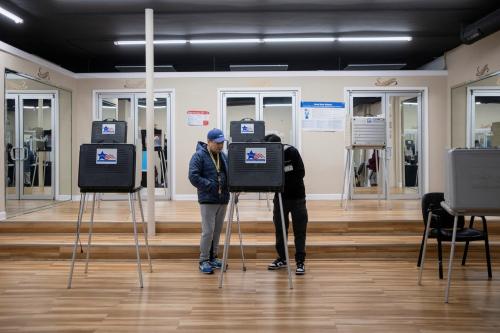Tuesday’s election might someday be seen as a historic turning point in American politics: the last time a major party candidate could hope to win the presidency with a campaign aimed directly at the nation’s “mainstream” white population.
If that was Mitt Romney’s strategy, he succeeded wildly, gaining a nearly unprecedented Republican vote advantage over Democrats among whites, 59 percent to 39 percent.
In the end though, he lost largely by ignoring the rising clout of the country’s minority population, including blacks, Asian Americans and especially Hispanics.
The failure to reach out more to these groups went a long way toward costing him the presidency, leading to losses in rapidly growing swing states like Nevada, Colorado, Virginia, Florida, and almost North Carolina—states that that once stood squarely within the GOP’s Sun Belt wheelhouse. In each of these states, through enthusiastic turnout or stronger support, Hispanics made bigger contributions to Obama’s election than in 2008.
Romney’s blind spot was Obama’s strength. He continued his 2008 strategy of expanding the Democratic base in growing regions, including the Southeast and Mountain West, and among select demographic groups—including young people, college graduates and single women—after two elections of relative stagnation.
Yet, the part of this coalition that will bring its longest run benefit to the Democrats is the strong appeal to minorities, which Obama carried by a margin of roughly 80 percent in the past two elections.
That minorities accounted for a historic high (28 percent) of voters in Tuesday’s elections had much to do with his popular vote advantage. Minority representation will continue as millennials, whose eligible voters are 39 percent minority, grow older. More pronounced will be the effect of U.S.-born children, 46 percent minority (including 23 percent Hispanics), become voting age citizens.
Yet, as much as these trends hold future advantages, Democrats may also be developing their own blind spot in failing to cultivate greater support among whites, including those who older, married, and without college educations. The mere 39 percent support Obama received from whites on Tuesday was the lowest for a Democrat since 1992, when third party candidate Ross Perot drew votes away from both Bill Clinton and Republican George H. W. Bush; and the 20 point marginal loss to Republicans was the biggest since 1984 when Walter Mondale lost to Ronald Reagan.
Some of this widening white deficit can be attributed to extremely poor showings in states that are well outside Democratic reach, such as Mississippi and Alabama with Republican margins of 79 and 69 points respectively. Still, most states in regions where comparisons could be made showed worse Democratic support among whites on Tuesday than in the previous election. Democrats did worse among white demographic groups, including white millennials who switched from Democratic support in 2008 to GOP support (though overall millennials still favored Obama).
Of course, whites matter and, in fact, made a difference in Ohio, Pennsylvania, Michigan, and Wisconsin where more modest Republican margins in the 5-17 percent range allowed strong black minority turnout to win those states for Obama. These are areas with a union tradition among working class whites, and where Romney’s personal appeal was not particularly strong. They are also relatively “white” states. So any reduction in Republican support will have a big impact and allow enthusiastic minority support for Democrats to triumph.
Similarly, reduced white margins will put in play previously safe Republican states in the Sun Belt. This was the case in 2008 when North Carolina landed in the Democratic column. Yet this time its increased white Republican margin put the Tar Heel State out of reach. Virginia, a state with a substantial northern born white population, kept its Republican margins lean this time, making it a continued Democratic player.
More fast-growing states in the Southeast and Mountain West still lie in the province of Republicans (think Texas, Georgia, and Arizona), but their changing demography, coupled with greater Democratic appeal to whites, will gradually change this (witness Florida, Nevada and Colorado). Until those shifts occur, the mainstays of Democratic support will be mostly slow growing states in the industrial Midwest, New England and the urban coasts—with many of them largely white.
While it is true that demography is on the Democrats side long term, they cannot count on minorities alone to drive their train to victory in the next presidential cycle or two.
It’s possible they dodged a bullet this time because of a Republican strategy which almost ignored minority interests. Because the most racially diverse part of the population is not yet old enough to vote and because voter participation is still highest among mostly white, older people (persons over age 45 cast 54 percent of Tuesday’s votes), Democrats will have to cater more to whites. On the other side of the aisle, Republicans will have to open their doors to Hispanics and other minorities as they become part of the new American “mainstream.”


Commentary
Op-edOn Election Day, A New American Mainstream
November 8, 2012